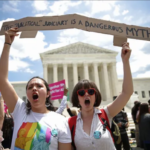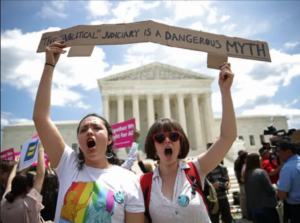Don’t Hope for a Biden Pick, Dream of Abolishing the Supreme Court

 The thing we knew would happen any day now happened. Justice Ruth Bader Ginsburg is dead.
The thing we knew would happen any day now happened. Justice Ruth Bader Ginsburg is dead.
Trump is now on the verge of being able to place a nightmare Justice on this court, giving it a 6-3 imbalance in favor of the conservative Justices. Similar to basically everyone he appoints to any position in government, his nominee is an absolute villain for the job.
A judge from the 7th Circuit Court of Appeals (the Federal appeals court seated in Chicago) Amy Coney Barrett is anti-LGBT, anti-choice, hyper-religious, and anti-healthcare—not the traits you’d look for in someone who would be called by the title “Justice.”
Trump hopes that Barrett would replace Ruth Bader Ginsburg, who made her judicial mark with, among other things, her work on gender equality, abortion access, and voting rights. I am an employment rights’ attorney and a woman. I owe a lot to Justice Ginsburg’s work and her legacy.
As far as Supreme Court justices go, she was good. But, of course, you know that. The internet bursts with inspirational eulogizing. In life, she was hailed a hero, in death, she is absolutely sanctified. Just look her up on Etsy.com and you’ll see what I mean.
In three decades on the Supreme Court, Justice Ginsburg had great power to shape our lives and little accountability outside her colleagues on the bench. While we applaud her sharp dissents and groundbreaking work, we must also be cautious of the superhero sheen that blinds us to her harms.
Historically, Ginsburg sided against indigenous sovereignty. She called Colin Kaepernick’s protest “really dumb. She had just one Black clerk in thirty years on the bench. She voted to reject the argument that pretrial detention does not qualify as imprisonment in federal law. She sided with conservatives to endorse the Atlantic Coast Pipeline. She agreed with the Trump administration to expedite deportation of asylum seekers. Justice Ginsberg, despite her important work for gender equality, was not so reliable on racial equality.
***
Understandably, Justice Ginsberg’s death caused a wave of panic among reproductive rights activists. If you google Roe v. Wade, the first listing on the auto-complete is “overturned.” Lots of people are rightfully freaking out. The anti-abortion movement has a long line of hopeful cases, which, if taken up by the Supreme Court, pose direct threats to Roe.
Overturning Roe would be devastating. It would not make abortion illegal but would leave the matter to be determined by state law. Four states have automatic bans at the ready. Ten states have pre-Roe bans that could automatically return, and many other states have vowed to ban abortion to the fullest extent possible.
That said, the threat of “losing Roe” has been the siren song of mainstream abortion rights organizations to lure activists onto the rocky coast of the Democratic Party, steering energy away from protest and speakouts, and into lobbying and electoral campaigns.
Now, with Justice Ginsberg’s death, the internet is bursting with (mostly white) women who are terrified (rightfully so) about losing the constitutional right to abortion. The answer for them is to vote for Biden so he can nominate the right kind of Supreme Court Justice who will save Roe.
The Democratic Party’s promise to save Roe rings hollow for thousands of people who have effectively already lost Roe. For people on Medicaid who can’t borrow enough money to pay for the procedure—Roe is gone. For people in the military who are not victims of rape or incest or impending death from the pregnancy—we are already post-Roe. For people who live too far from a clinic in a state without public transit, for people who will lose their jobs for taking too much time off to meet onerous counseling requirements, for minors who fail to convince a judge that they are mature enough, or minors who are undocumented. Or for anyone tricked by a fake pregnancy clinic into believing their pregnancy is still in its earlier stages so the deadline for a legal abortion passes without notice. For all those people, Roe is already lost.
Moreover, abortion is just a part of reproductive justice. Recently, mass hysterectomies have allegedly been forced on women in detention centers. The assault on the reproductive lives of women of color is threaded through US history. This violence is not only our history but rather also continues today.
Based on her history, Judge Barret would likely vote to overturn Roe. Still, Supreme Court Justices can be unpredictable. Justice Ginsburg, historically anti-indigenous sovereignty, sided with the tribes in the McGirt v. Oklahoma decision this year in support of indigenous sovereignty. She also apologized about her comments on Kaepernick.
Also unpredictably, this year the Court upheld LGBT workplace protections in Bostock v. Clayton County, struck down a Louisiana anti-abortion law in June Medical Services v. Russo, and rejected the Trump administration’s attempt to end DACA. In all three cases, Chief Justice Roberts, generally conservative, sided with generally liberal Justices Kagan, Ginsburg, Breyer, and Sotomayor in the majority opinion.
In Bostock, Justice Gorsuch wrote the majority opinion! Justice Gorsuch replaced his late judicial icon, the raging homophobe Antonin Scalia. Gorsuch endorses the same juridical principles as Scalia. But Gorsuch blindsided us when he used a textualist approach to find that transgender workers are protected by federal law.
Roe v. Wade was passed by a Court with four justices appointed by Nixon, two by Eisenhower. One of the Nixon appointees wrote the opinion and two joined it. Probably less because those judges took a closer look at the constitution and realized that it protects the bodily autonomy of people with uteruses, and more because there was a mass movement pounding at the door. That said, since the 1980s, Republican presidents have been more careful to nominate only hard-right justices (with the one exception of Souter).
This might sound confusing, because the Supreme Court is supposedly a nonpolitical body that is removed from democratic election so that it may be an impartial check on undemocratic or tyrannical actions by the Executive or Legislative branches.
Of course, we know that’s not true. First, the Supreme Court is nine un-elected people appointed for life who make consequential decisions that impact the lives of millions of people. Those decisions are nearly always founded in precedent, which necessarily means looking backward. This has no place in a democracy, which is supposed to be based on the will of the people. (That is, the will of the representatives elected by the majority of voters, which in reality also operates undemocratically as campaign promises are rarely fulfilled and recalling an elected official is nearly impossible. But that discussion is outside the scope of this article). The reason the Court sometimes responds to mass movements is that the Justices recognize their decisions must have broad legitimacy and that their role is to maintain social stability. That’s why they have been so cautious to overturn Roe wholesale even though it’s been challenged since it was first decided.
Second, the Court is very much a political body. Despite the alleged political neutrality, we still know who the conservative and liberal judges are. The Supreme Court does not actually act as a check on undemocratic rule of the other branches. Instead, Keeanga-Yamahtta Taylor in a brilliant article, “The Case for Ending the Supreme Court as We Know It” published in The New Yorker argues, the Supreme Court appointments “reflect the current balance or imbalance of political power, making it impossible to neatly untie them from the political bodies that determine who sits on the Court and who does not.” One need only recognize that Trump is likely to appoint a full third of the Supreme Court before he leaves office, giving him, in Taylor’s words, “one more opportunity to limit the political rights of the minority populations that he disparages and despises.”
Taylor explains the legacy of the Supreme Court as enforcing conservative social order, which it has done for most of its existence with one limited exception in the 50s and 60s. That decade stands out as an anomaly because the U.S. state was under tremendous pressure here and abroad and needed to project itself as a beacon of democracy to hide the racial injustice raging at home. With that exception, Taylor explains, the Court is a force of conservatism. Even in socially progressive decisions, such as Brown v. Board of Education, the Supreme Court often merely undoes the harm of its own earlier decisions.
I won’t list all the cases that any decent human would consider were decided the wrong way (looking at you, Plessy v. Ferguson, Koramatsu v. United States, Bowers v. Hardwick). The law is the smoke and mirrors that legitimizes a system of exploitation and corruption. “Legal” doesn’t mean “just,” “moral,” or “humane.” It means lawfully permissible. The Supreme Court, when it decides cases in the interest of social justice, simply tails the social standards that we have already set. The Court does not disrupt the status quo.
These days, the status quo is failing. For some people, the status quo is fatal. The status quo is cracking and everything about our society is up for debate. The Left is thinking it, the far-Right is thinking it. We know what we don’t want; we must also be re-thinking what kind of society we do want.As a socialist, I believe the way forward is collective action. As Taylor said on Democracy Now, we have the parts of a mass movement: numbers, discontent, passion. Trump is not as popular as the media make him seem. The right wing is not as big as they pretend they are. Trump has almost a 40% approval rating, right? Well, 100 million people didn’t vote at all in the 2016 Presidential election. According to the New York Times, 15-26 million people participated in Black Lives Matter protests this summer – that was the largest movement in U.S. history.
We deserve a better world and we can make one. On our way, we need to abolish the Supreme Court. We’re obviously not there yet. We can call this a “yes, and.” Yes, we must abolish the Supreme Court because it is the antithesis of democratic decision-making. AND right now we need to organize to stop Trump’s nomination of a super-villain for a lifetime appointment on the highest judicial body.